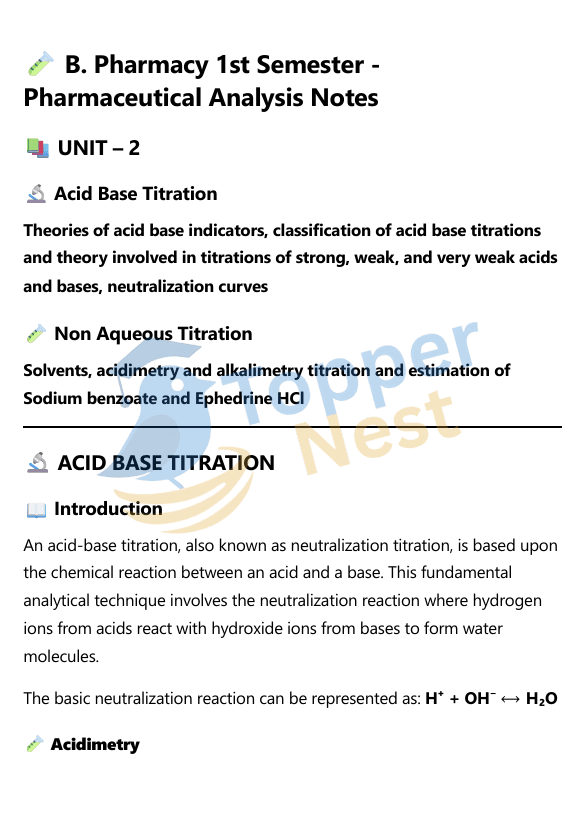This unit builds the foundational knowledge of titrations by exploring acid-base titration theories and the use of non-aqueous solvents to estimate substances that are poorly soluble or weakly ionized in water. These methods are important for analyzing a wide range of pharmaceutical compounds accurately. If you want more notes related B. Pharmacy: TopperNest.

Definition of Acid-Base Titrations
Acid-Base Titrations are a fundamental quantitative analytical technique used to determine the unknown concentration of an acid or a base by neutralizing it with a solution of known concentration (a “standard solution”). This method is based on the chemical reaction between an acid and a base, which typically forms a salt and water (a neutralization reaction).
Principle of Acid-Base Titration:
The core principle is the stoichiometric reaction between the acid and base. At the equivalence point, the exact number of moles of the acid has reacted with the exact number of moles of the base. This means that they have completely neutralized each other according to their balanced chemical equation.
For example, in the reaction between hydrochloric acid (HCl) and sodium hydroxide (NaOH):HCl(aq)+NaOH(aq)→NaCl(aq)+H2O(l)
At the equivalence point, the moles of HCl added will equal the moles of NaOH initially present (or vice-versa).
Theories of Acid-Base Indicators
Indicators are substances that change color at a specific pH range and help identify the end point of a titration. Their function is explained by:
- Ostwald’s Theory: Indicators are weak acids or bases that dissociate in solution and change color based on the concentration of H⁺ or OH⁻ ions.
- Quinonoid Theory: Color change occurs due to structural change in the indicator molecule between its acidic and basic forms.
What is Non-Aqueous Titrations?
Non-Aqueous Titrations are a type of volumetric analysis where the analyte (the substance being analyzed) is dissolved in a solvent other than water. This technique is specifically employed for the assay (quantitative determination) of substances that are:
- Insoluble in water: Many organic compounds, including a vast number of pharmaceutical active ingredients, do not dissolve well in water.
- Very weak acids or very weak bases: In an aqueous (water) solution, very weak acids and bases tend to ionize (dissociate into ions) poorly. Since water itself can act as both a very weak acid and a very weak base, it “competes” with the analyte for proton donation or acceptance. This competition leads to a very small and poorly defined endpoint in traditional aqueous titrations, making accurate quantification difficult or impossible.
Types of Non-Aqueous Solvents
Besides protogenic and protophilic, there are:
- Aprotic Solvents: Chemically inert, neither donate nor accept protons (e.g., benzene, chloroform, acetonitrile). They are mainly used for dissolving the analyte without interfering with the reaction.
- Amphiprotic Solvents: Can act as both proton donors and acceptors (e.g., alcohols, water). While water is generally avoided, some amphiprotic organic solvents can be useful.
Frequently Asked Questions (FAQs)
1. What is the purpose of acid-base titration in pharmaceutical analysis?
Acid-base titrations are used to determine the concentration of acidic or basic drug substances. They help assess purity and dosage strength in formulations.
2. How do indicators work in acid-base titrations?
Indicators are weak acids or bases that change color at specific pH levels. They signal the end point of a titration by changing color when the titration is complete.
3. Why are different indicators used for different titrations?
Each acid-base titration has a different pH range at the equivalence point. Choosing an indicator with a matching color change range ensures accurate detection of the end point.
4. What are neutralization curves and why are they important?
Neutralization curves graph pH changes during titration. They help visualize the point at which neutralization occurs and assist in selecting the right indicator.
5. What is non-aqueous titration and when is it used?
Non-aqueous titration is performed in organic solvents instead of water. It is used for substances that are weakly acidic or basic and poorly soluble in water.
